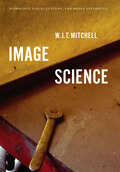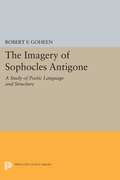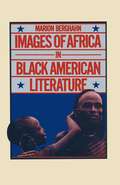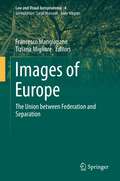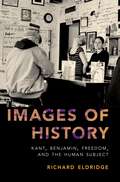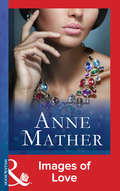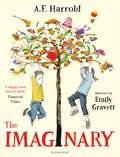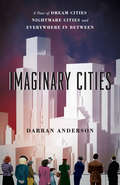- Table View
- List View
The Image of the Puppet in Italian Theater, Literature and Film
by Federico PacchioniWith the advancement of cybernetics, avatars, animation, and virtual reality, a thorough understanding of how the puppet metaphor originates from specific theatrical practices and media is especially relevant today. This book identifies and interprets the aesthetic and cultural significance of the different traditions of the Italian puppet theater in the broader Italian culture and beyond. Grounded in the often-overlooked history of the evolution of several Italian puppetry traditions – the central and northern Italian stringed marionettes, the Sicilian pupi, the glove puppets of the Po Valley, and the Neapolitan Pulcinella – this study examines a broad spectrum of visual, cinematic, literary, and digital texts representative of the functions and themes of the puppet. A systematic analysis of the meanings ascribed to the idea and image of the puppet provides a unique vantage point to observe the perseverance and transformation of its deeper associations, linking premodern, modern, and contemporary contexts.
The Image of Women in Contemporary Soviet Fiction: Selected Short Stories from the USSR
by transThe stories in this collection portray Soviet women of different ages and educational backgrounds at home and at work, in cities and villages. Their themes reflect the social changes in Soviet life in the past 20 years, and are aimed to stimulate inquiry into social and feminist issues.
An Image Of You (Mills And Boon Cherish Ser.)
by Liz FieldingAN IMAGE OF YOU The rebel and the artist
The Image of You: I thought I knew you. But you're a liar.
by Adele ParksThe Image of You is the utterly gripping new novel from Adele Parks, author of the No. 1 bestselling ebook, The Stranger In My Home. This story of families, love, deception and secrets is perfect for fans of TV's Doctor Foster, Liar, The Replacement, Liane Moriarty's Big Little Lies and Shari Lapena. 'Brilliant storyline, great characters, very clever, loved it!' B A Paris'Addictive and perceptive' Lucy Atkins'A compelling and gripping story of secrets and lies' Daily ExpressCan you ever trust someone you meet online?Anna and Zoe are twins. Identical in appearance, utterly different in personality, they share a bond so close that nothing - or no one - can rip them apart.Until Anna meets charismatic Nick.Anna is trusting, romantic and hopeful; she thinks Nick is perfect.Zoe is daring, dangerous and extreme; she thinks Nick is a liar.Zoe has seen Anna betrayed by men before. She'll stop at nothing to discover if Nick is as good as he seems. Lies may hurt. But honesty can kill.
Image Science: Iconology, Visual Culture, and Media Aesthetics
by W. J. MitchellAlmost thirty years ago, W. J. T. Mitchell’s Iconology helped launch the interdisciplinary study of visual media, now a central feature of the humanities. Along with his subsequent Picture Theory and What Do Pictures Want?, Mitchell’s now-classic work introduced such ideas as the pictorial turn, the image/picture distinction, the metapicture, and the biopicture. These key concepts imply an approach to images as true objects of investigation—an “image science.” Continuing with this influential line of thought, Image Science gathers Mitchell’s most recent essays on media aesthetics, visual culture, and artistic symbolism. The chapters delve into such topics as the physics and biology of images, digital photography and realism, architecture and new media, and the occupation of space in contemporary popular uprisings. The book looks both backward at the emergence of iconology as a field and forward toward what might be possible if image science can indeed approach pictures the same way that empirical sciences approach natural phenomena. Essential for those involved with any aspect of visual media, Image Science is a brilliant call for a method of studying images that overcomes the “two-culture split” between the natural and human sciences.
Image Science: Iconology, Visual Culture, and Media Aesthetics
by W. J. MitchellAlmost thirty years ago, W. J. T. Mitchell’s Iconology helped launch the interdisciplinary study of visual media, now a central feature of the humanities. Along with his subsequent Picture Theory and What Do Pictures Want?, Mitchell’s now-classic work introduced such ideas as the pictorial turn, the image/picture distinction, the metapicture, and the biopicture. These key concepts imply an approach to images as true objects of investigation—an “image science.” Continuing with this influential line of thought, Image Science gathers Mitchell’s most recent essays on media aesthetics, visual culture, and artistic symbolism. The chapters delve into such topics as the physics and biology of images, digital photography and realism, architecture and new media, and the occupation of space in contemporary popular uprisings. The book looks both backward at the emergence of iconology as a field and forward toward what might be possible if image science can indeed approach pictures the same way that empirical sciences approach natural phenomena. Essential for those involved with any aspect of visual media, Image Science is a brilliant call for a method of studying images that overcomes the “two-culture split” between the natural and human sciences.
Image Science: Iconology, Visual Culture, and Media Aesthetics
by W. J. MitchellAlmost thirty years ago, W. J. T. Mitchell’s Iconology helped launch the interdisciplinary study of visual media, now a central feature of the humanities. Along with his subsequent Picture Theory and What Do Pictures Want?, Mitchell’s now-classic work introduced such ideas as the pictorial turn, the image/picture distinction, the metapicture, and the biopicture. These key concepts imply an approach to images as true objects of investigation—an “image science.” Continuing with this influential line of thought, Image Science gathers Mitchell’s most recent essays on media aesthetics, visual culture, and artistic symbolism. The chapters delve into such topics as the physics and biology of images, digital photography and realism, architecture and new media, and the occupation of space in contemporary popular uprisings. The book looks both backward at the emergence of iconology as a field and forward toward what might be possible if image science can indeed approach pictures the same way that empirical sciences approach natural phenomena. Essential for those involved with any aspect of visual media, Image Science is a brilliant call for a method of studying images that overcomes the “two-culture split” between the natural and human sciences.
Image Science: Iconology, Visual Culture, and Media Aesthetics
by W. J. MitchellAlmost thirty years ago, W. J. T. Mitchell’s Iconology helped launch the interdisciplinary study of visual media, now a central feature of the humanities. Along with his subsequent Picture Theory and What Do Pictures Want?, Mitchell’s now-classic work introduced such ideas as the pictorial turn, the image/picture distinction, the metapicture, and the biopicture. These key concepts imply an approach to images as true objects of investigation—an “image science.” Continuing with this influential line of thought, Image Science gathers Mitchell’s most recent essays on media aesthetics, visual culture, and artistic symbolism. The chapters delve into such topics as the physics and biology of images, digital photography and realism, architecture and new media, and the occupation of space in contemporary popular uprisings. The book looks both backward at the emergence of iconology as a field and forward toward what might be possible if image science can indeed approach pictures the same way that empirical sciences approach natural phenomena. Essential for those involved with any aspect of visual media, Image Science is a brilliant call for a method of studying images that overcomes the “two-culture split” between the natural and human sciences.
Image Science: Iconology, Visual Culture, and Media Aesthetics
by W. J. MitchellAlmost thirty years ago, W. J. T. Mitchell’s Iconology helped launch the interdisciplinary study of visual media, now a central feature of the humanities. Along with his subsequent Picture Theory and What Do Pictures Want?, Mitchell’s now-classic work introduced such ideas as the pictorial turn, the image/picture distinction, the metapicture, and the biopicture. These key concepts imply an approach to images as true objects of investigation—an “image science.” Continuing with this influential line of thought, Image Science gathers Mitchell’s most recent essays on media aesthetics, visual culture, and artistic symbolism. The chapters delve into such topics as the physics and biology of images, digital photography and realism, architecture and new media, and the occupation of space in contemporary popular uprisings. The book looks both backward at the emergence of iconology as a field and forward toward what might be possible if image science can indeed approach pictures the same way that empirical sciences approach natural phenomena. Essential for those involved with any aspect of visual media, Image Science is a brilliant call for a method of studying images that overcomes the “two-culture split” between the natural and human sciences.
Image Science: Iconology, Visual Culture, and Media Aesthetics
by W. J. MitchellAlmost thirty years ago, W. J. T. Mitchell’s Iconology helped launch the interdisciplinary study of visual media, now a central feature of the humanities. Along with his subsequent Picture Theory and What Do Pictures Want?, Mitchell’s now-classic work introduced such ideas as the pictorial turn, the image/picture distinction, the metapicture, and the biopicture. These key concepts imply an approach to images as true objects of investigation—an “image science.” Continuing with this influential line of thought, Image Science gathers Mitchell’s most recent essays on media aesthetics, visual culture, and artistic symbolism. The chapters delve into such topics as the physics and biology of images, digital photography and realism, architecture and new media, and the occupation of space in contemporary popular uprisings. The book looks both backward at the emergence of iconology as a field and forward toward what might be possible if image science can indeed approach pictures the same way that empirical sciences approach natural phenomena. Essential for those involved with any aspect of visual media, Image Science is a brilliant call for a method of studying images that overcomes the “two-culture split” between the natural and human sciences.
Image Science: Iconology, Visual Culture, and Media Aesthetics
by W. J. MitchellAlmost thirty years ago, W. J. T. Mitchell’s Iconology helped launch the interdisciplinary study of visual media, now a central feature of the humanities. Along with his subsequent Picture Theory and What Do Pictures Want?, Mitchell’s now-classic work introduced such ideas as the pictorial turn, the image/picture distinction, the metapicture, and the biopicture. These key concepts imply an approach to images as true objects of investigation—an “image science.” Continuing with this influential line of thought, Image Science gathers Mitchell’s most recent essays on media aesthetics, visual culture, and artistic symbolism. The chapters delve into such topics as the physics and biology of images, digital photography and realism, architecture and new media, and the occupation of space in contemporary popular uprisings. The book looks both backward at the emergence of iconology as a field and forward toward what might be possible if image science can indeed approach pictures the same way that empirical sciences approach natural phenomena. Essential for those involved with any aspect of visual media, Image Science is a brilliant call for a method of studying images that overcomes the “two-culture split” between the natural and human sciences.
An Image to Die For (Sam Dean Thriller #4)
by Mike PhillipsBehind the scenes of television production journalist-turned-investigator, Sam Dean, discovers greed, ugliness and murder. When a TV producer offers journalist Sam Dean the job of tracking down a suspect in the brutal murder of a young woman and her child, he's reluctant to get involved. But when a colleague is stabbed to death on set, it’s clear something bigger is going on. And when threatening anonymous notes start arriving, Sam is forced to dig for the truth… Standing astride 1980s London’s sharp racial divides, An Image to Die For is a crime thriller perfect for fans of S.A. Cosby and Walter Mosley.
Imagery of Sophocles Antigone
by Robert Francis GoheenA systematic investigation of a Greek text, employing the techniques of the "new criticism." The book is a major contribution to the study of Sophocles and of Greek drama.Originally published in 1951.The Princeton Legacy Library uses the latest print-on-demand technology to again make available previously out-of-print books from the distinguished backlist of Princeton University Press. These editions preserve the original texts of these important books while presenting them in durable paperback and hardcover editions. The goal of the Princeton Legacy Library is to vastly increase access to the rich scholarly heritage found in the thousands of books published by Princeton University Press since its founding in 1905.
Images of Europe: The Union between Federation and Separation (Law and Visual Jurisprudence #4)
by Francesco Mangiapane Tiziana MiglioreThis book deals with the fundamental semantics of images of Europe, which consist of valences, mirror beliefs and affectivities. This is why it relaunches the importance of the European discourse in its symbolic dimension. As such, it explores the many images of Europe, or rather the many images through which European discourse is actually constituted in daily life, in search of their enunciative responsibility in today’s world for determining the current “State of the Union”. The identity of the European continent is based on a millenary tension between universalism and particularism: images of Europe have in fact been alternately inspired, over the centuries, by a model of homogeneity – Roman and Carolingian imperial disposition – on the one hand, and by a model of fragmentation – a Europe of city-states, municipalities, regions and small fatherlands – on the other. In the European Union, a political and economic organism, this issue has recently been amplified to the point that it has reentered public debate, and political parties that are only recognizable for being Europeanists or anti-Europeanists are now ubiquitous. In this regard, one major bone of contention is how to portray the quintessential aspects of the European territory, which are either interpreted as “thresholds” to be overcome in the name of a model of United Europe – “integral totality” – or are instead regarded as insurmountable obstacles for a Europe that is irreparably and perhaps, according to anti-Europeanists, fortunately fragmented – “partitive totality”. Further, this is to be done without excluding the possibility of contradictory and complementary solutions to these binary visions. In this context the book analyzes various texts in order to obtain a more precise picture of the clash, reveal its semiotic forms, and by doing so, identify a way out of the crisis.
Images of History: Kant, Benjamin, Freedom, and the Human Subject
by Richard EldridgeDeveloping work in the theories of action and explanation, Eldridge argues that moral and political philosophers require accounts of what is historically possible, while historians require rough philosophical understandings of ideals that merit reasonable endorsement. Both Immanuel Kant and Walter Benjamin recognize this fact. Each sees a special place for religious consciousness and critical practice in the articulation and revision of ideals that are to have cultural effect, but they differ sharply in the forms of religious-philosophical understanding, cultural criticism, and political practice that they favor. Kant defends a liberal, reformist, Protestant stance, emphasizing the importance of liberty, individual rights, and democratic institutions. His fullest picture of movement toward a moral culture appears in Religion within the Bounds of Mere Reason, where he describes conjecturally the emergence of an ethical commonwealth. Benjamin defends a politics of improvisatory alertness and consciousness-raising that is suspicious of progress and liberal reform. He practices a form of modernist, materialist criticism that is strongly rooted in his encounters with Kant, Hölderlin, and Goethe. His fullest, finished picture of this critical practice appears in One-Way Street, where he traces the continuing force of unsatisfied desires. By drawing on both Kant and Benjamin, Eldridge hopes to avoid both moralism (standing on sharply specified normative commitments at all costs) and waywardness (rejecting all settled commitments). And in doing so, he seeks to make better sense of the commitment-forming, commitment-revising, anxious, reflective and sometimes grownup acculturated human subjects we are.
Images of History: Kant, Benjamin, Freedom, and the Human Subject
by Richard EldridgeDeveloping work in the theories of action and explanation, Eldridge argues that moral and political philosophers require accounts of what is historically possible, while historians require rough philosophical understandings of ideals that merit reasonable endorsement. Both Immanuel Kant and Walter Benjamin recognize this fact. Each sees a special place for religious consciousness and critical practice in the articulation and revision of ideals that are to have cultural effect, but they differ sharply in the forms of religious-philosophical understanding, cultural criticism, and political practice that they favor. Kant defends a liberal, reformist, Protestant stance, emphasizing the importance of liberty, individual rights, and democratic institutions. His fullest picture of movement toward a moral culture appears in Religion within the Bounds of Mere Reason, where he describes conjecturally the emergence of an ethical commonwealth. Benjamin defends a politics of improvisatory alertness and consciousness-raising that is suspicious of progress and liberal reform. He practices a form of modernist, materialist criticism that is strongly rooted in his encounters with Kant, Hölderlin, and Goethe. His fullest, finished picture of this critical practice appears in One-Way Street, where he traces the continuing force of unsatisfied desires. By drawing on both Kant and Benjamin, Eldridge hopes to avoid both moralism (standing on sharply specified normative commitments at all costs) and waywardness (rejecting all settled commitments). And in doing so, he seeks to make better sense of the commitment-forming, commitment-revising, anxious, reflective and sometimes grownup acculturated human subjects we are.
Images Of Love (Mills And Boon Modern Ser.)
by Anne MatherMills & Boon are excited to present The Anne Mather Collection – the complete works by this classic author made available to download for the very first time! These books span six decades of a phenomenal writing career, and every story is available to read unedited and untouched from their original release. A desire reawakened…
Images of the American City
by Anselm L. StraussOriginally published in 1961, Images of the American City examines how Americans dealt with the rapid shock of urbanization as it evolved from an agricultural nation. Working from the framework of a social psychologist, Anselm L. Strauss offers a deeper look into the sociological, psychological, and historical perspectives of urban development. He describes how the cultural changes of a space ultimately develop urban imagery by looking towards the urbanization of America from peoples' views of the cities rather than how the cities are themselves. Urban imageries are contrasted with the context of an ideal city and visitors' perspectives of cities. Strauss takes a step back to ask questions about what Americans think and have thought of their cities. How do these cities compare to the image of an ideal city? What are the different perspectives between a city-dweller and a visitor? He contrasts the tension between those within the city and those outside of its urban limits. Strauss describes how space and time are major themes in the symbolic urbanization of a city. He offers a macroscopic view of the city as a whole and shows how urban imageries evolved from changes in lifestyles. He then provides historical breakdowns of different regions of the country and how they were urbanized. This book documents and illustrates the change in American symbolization from the growth of American cities to the union of urbanity and rurality.
Images of the American City
by Anselm L. StraussOriginally published in 1961, Images of the American City examines how Americans dealt with the rapid shock of urbanization as it evolved from an agricultural nation. Working from the framework of a social psychologist, Anselm L. Strauss offers a deeper look into the sociological, psychological, and historical perspectives of urban development. He describes how the cultural changes of a space ultimately develop urban imagery by looking towards the urbanization of America from peoples' views of the cities rather than how the cities are themselves. Urban imageries are contrasted with the context of an ideal city and visitors' perspectives of cities. Strauss takes a step back to ask questions about what Americans think and have thought of their cities. How do these cities compare to the image of an ideal city? What are the different perspectives between a city-dweller and a visitor? He contrasts the tension between those within the city and those outside of its urban limits. Strauss describes how space and time are major themes in the symbolic urbanization of a city. He offers a macroscopic view of the city as a whole and shows how urban imageries evolved from changes in lifestyles. He then provides historical breakdowns of different regions of the country and how they were urbanized. This book documents and illustrates the change in American symbolization from the growth of American cities to the union of urbanity and rurality.
The Imaginary
by Emily Gravett A. F. HarroldRudger is Amanda Shuffleup's imaginary friend. Nobody else can see Rudger--until the evil Mr. Bunting arrives at Amanda's door. Mr. Bunting hunts imaginaries. Rumor has it that he even eats them. And now he's found Rudger.Soon Rudger is alone, and running for his imaginary life. He needs to find Amanda before Mr. Bunting catches him--and before Amanda forgets him and he fades away to nothing. But how can an unreal boy stand alone in the real world?In the vein of Coraline, this gripping take on imaginary friends comes to life in a lush package: beautiful illustrations (10 in full color) by acclaimed artist Emily Gravett, a foiled and debossed case cover, printed endpapers, and deckled page edges.
The Imaginary
by A. F. Harrold Emily GravettRudger is Amanda's best friend. He doesn't exist, but nobody's perfect. Only Amanda can see her imaginary friend – until the sinister Mr Bunting arrives at Amanda's door. Mr Bunting hunts imaginaries. Rumour says that he eats them. And he's sniffed out Rudger. Soon Rudger is alone, and running for his imaginary life. But can a boy who isn't there survive without a friend to dream him up? A brilliantly funny, scary and moving read from the unique imagination of A.F. Harrold, this beautiful book is astoundingly illustrated with integrated art and colour spreads by the award-winning Emily Gravett.
Imaginary Cities: A Tour of Dream Cities, Nightmare Cities, and Everywhere in Between
by Darran AndersonFor as long as humans have gathered in cities, those cities have had their shining—or shadowy—counterparts. Imaginary cities, potential cities, future cities, perfect cities. It is as if the city itself, its inescapable gritty reality and elbow-to-elbow nature, demands we call into being some alternative, yearned-for better place. This book is about those cities. It’s neither a history of grand plans nor a literary exploration of the utopian impulse, but rather something different, hybrid, idiosyncratic. It’s a magpie’s book, full of characters and incidents and ideas drawn from cities real and imagined around the globe and throughout history. Thomas More’s allegorical island shares space with Soviet mega-planning; Marco Polo links up with James Joyce’s meticulously imagined Dublin; the medieval land of Cockaigne meets the hopeful future of Star Trek. With Darran Anderson as our guide, we find common themes and recurring dreams, tied to the seemingly ineluctable problems of our actual cities, of poverty and exclusion and waste and destruction. And that’s where Imaginary Cities becomes more than a mere—if ecstatically entertaining—intellectual exercise: for, as Anderson says, “If a city can be imagined into being, it can be re-imagined.” Every architect, philosopher, artist, writer, planner, or citizen who dreams up an imaginary city offers lessons for our real ones; harnessing those flights of hopeful fancy can help us improve the streets where we live. Though it shares DNA with books as disparate as Calvino’s Invisible Cities and Jane Jacobs’s Death and Life of Great American Cities, there’s no other book quite like Imaginary Cities. After reading it, you’ll walk the streets of your city—real or imagined—with fresh eyes.
Imaginary Cities: A Tour of Dream Cities, Nightmare Cities, and Everywhere in Between
by Darran AndersonFor as long as humans have gathered in cities, those cities have had their shining—or shadowy—counterparts. Imaginary cities, potential cities, future cities, perfect cities. It is as if the city itself, its inescapable gritty reality and elbow-to-elbow nature, demands we call into being some alternative, yearned-for better place. This book is about those cities. It’s neither a history of grand plans nor a literary exploration of the utopian impulse, but rather something different, hybrid, idiosyncratic. It’s a magpie’s book, full of characters and incidents and ideas drawn from cities real and imagined around the globe and throughout history. Thomas More’s allegorical island shares space with Soviet mega-planning; Marco Polo links up with James Joyce’s meticulously imagined Dublin; the medieval land of Cockaigne meets the hopeful future of Star Trek. With Darran Anderson as our guide, we find common themes and recurring dreams, tied to the seemingly ineluctable problems of our actual cities, of poverty and exclusion and waste and destruction. And that’s where Imaginary Cities becomes more than a mere—if ecstatically entertaining—intellectual exercise: for, as Anderson says, “If a city can be imagined into being, it can be re-imagined.” Every architect, philosopher, artist, writer, planner, or citizen who dreams up an imaginary city offers lessons for our real ones; harnessing those flights of hopeful fancy can help us improve the streets where we live. Though it shares DNA with books as disparate as Calvino’s Invisible Cities and Jane Jacobs’s Death and Life of Great American Cities, there’s no other book quite like Imaginary Cities. After reading it, you’ll walk the streets of your city—real or imagined—with fresh eyes.




